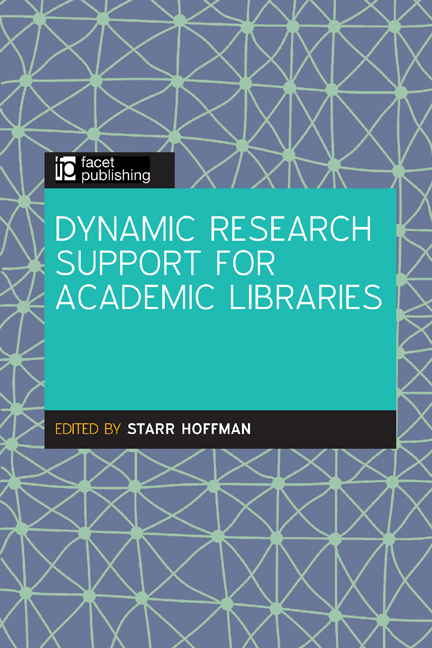Book contents
- Frontmatter
- Contents
- Editor and contributors
- Preface
- Introduction: a vision for supporting research
- PART 1 TRAINING AND INFRASTRUCTURE
- PART 2 DATA SERVICES AND DATA LITERACY
- PART 3 RESEARCH AS A CONVERSATION
- Introduction to Part 3
- 7 Implementing open access across a large university: a case study
- 8 Bridging the gap: easing the transition to higher education with an information literacy MOOC
- 9 Metadata enhancement through name authority in the UNT Digital Library
- Index
Introduction to Part 3
from PART 3 - RESEARCH AS A CONVERSATION
Published online by Cambridge University Press: 08 June 2018
- Frontmatter
- Contents
- Editor and contributors
- Preface
- Introduction: a vision for supporting research
- PART 1 TRAINING AND INFRASTRUCTURE
- PART 2 DATA SERVICES AND DATA LITERACY
- PART 3 RESEARCH AS A CONVERSATION
- Introduction to Part 3
- 7 Implementing open access across a large university: a case study
- 8 Bridging the gap: easing the transition to higher education with an information literacy MOOC
- 9 Metadata enhancement through name authority in the UNT Digital Library
- Index
Summary
The idea of research as a conversation
In 1941, Kenneth Burke was the first to use the metaphor of ‘research as a conversation’:
Imagine that you enter a parlor. You come late. When you arrive, others have long preceded you, and they are engaged in a heated discussion, a discussion too heated for them to pause and tell you exactly what it is about. In fact, the discussion had already begun long before any of them got there, so that no one present is qualified to retrace for you all the steps that had gone before. You listen for a while, until you decide that you have caught the tenor of the argument; then you put in your oar. Someone answers; you answer him; another comes to your defense; another aligns himself against you, to either the embarrassment or gratification of your opponent, depending upon the quality of your ally's assistance. However, the discussion is interminable. The hour grows late, you must depart. And you do depart, with the discussion still vigorously in progress.
Burke, 1974Although this metaphor is not new in academia, it persists because it is a succinct and accurate description of the ideal of building knowledge. The phrase describes new knowledge as not a ‘eureka’-like bolt of lightning out of a clear summer sky, but rather as something built upon the solid foundation of pre-existing research. Whether the existing research agrees with established research or questions and refutes it, it is clearly situated in the established research conversation. This metaphor touches on several key aspects of libraries: providing access to previous research, educating users in how to discover it and give credit to it, and helping students learn how to analyse, synthesize and respond to it.
This metaphor is complemented in 1962 by Thomas Kuhn's seminal work on research, The Structure of Scientific Revolutions (Kuhn, 1970), which describes paradigm-shifting moments in scientific research. Kuhn's view of the history of science challenged the then-popular view that science was merely an inevitable accumulation of facts over time leading to a single, coherent framework. Instead, Kuhn pointed out how scientific anomalies that don't fit into the existing framework (what Kuhn called the ‘dominant paradigm’) can lead to requestioning old data with new hypotheses (a period he called ‘scientific revolution’) and ultimately to a new paradigm.
- Type
- Chapter
- Information
- Dynamic Research Support for Academic Libraries , pp. 99 - 106Publisher: FacetPrint publication year: 2016

